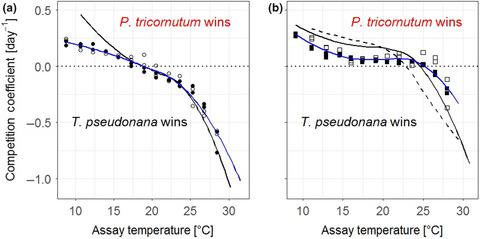当前位置:
X-MOL 学术
›
Ecol. Evol.
›
论文详情
Our official English website, www.x-mol.net, welcomes your feedback! (Note: you will need to create a separate account there.)
High predictability of direct competition between marine diatoms under different temperatures and nutrient states.
Ecology and Evolution ( IF 2.6 ) Pub Date : 2020-06-03 , DOI: 10.1002/ece3.6453 Philipp Siegel 1 , Kirralee G Baker 1 , Etienne Low-Décarie 2 , Richard J Geider 1
Ecology and Evolution ( IF 2.6 ) Pub Date : 2020-06-03 , DOI: 10.1002/ece3.6453 Philipp Siegel 1 , Kirralee G Baker 1 , Etienne Low-Décarie 2 , Richard J Geider 1
Affiliation

|
The distribution of marine phytoplankton will shift alongside changes in marine environments, leading to altered species frequencies and community composition. An understanding of the response of mixed populations to abiotic changes is required to adequately predict how environmental change may affect the future composition of phytoplankton communities. This study investigated the growth and competitive ability of two marine diatoms, Phaeodactylum tricornutum and Thalassiosira pseudonana , along a temperature gradient (9–35°C) spanning the thermal niches of both species under both high‐nitrogen nutrient‐replete and low‐nitrogen nutrient‐limited conditions. Across this temperature gradient, the competitive outcome under both nutrient conditions at any assay temperature, and the critical temperature at which competitive advantage shifted from one species to the other, was well predicted by the temperature dependencies of the growth rates of the two species measured in monocultures. The temperature at which the competitive advantage switched from P. tricornutum to T. pseudonana increased from 18.8°C under replete conditions to 25.3°C under nutrient‐limited conditions. Thus, P. tricornutum was a better competitor over a wider temperature range in a low N environment. Being able to determine the competitive outcomes from physiological responses of single species to environmental changes has the potential to significantly improve the predictive power of phytoplankton spatial distribution and community composition models.
中文翻译:

在不同温度和营养状态下,海洋硅藻之间直接竞争的高度可预测性。
海洋浮游植物的分布将随着海洋环境的变化而变化,从而导致物种频率和群落组成的改变。需要充分了解混合种群对非生物变化的反应,才能充分预测环境变化如何影响浮游植物群落的未来组成。这项研究调查了两个海洋硅藻,三角藻和拟南芥的生长和竞争能力。,在高氮养分充足和低氮养分有限的条件下,沿着跨两个物种的热生态位的温度梯度(9–35°C)。在此温度梯度范围内,两种营养物在任何测定温度下的竞争结果,以及竞争优势从一种物种转移到另一种物种的临界温度,都可以通过测量两种物种生长速率的温度依赖性来很好地预测单一文化。在该温度下的竞争优势从切换三角褐指藻到T. pseudonana养分受限条件下从充满的条件下18.8℃升高至25.3℃。因此,P。tricornutum在低氮环境下更宽的温度范围内,它是更好的竞争对手。能够确定单个物种对环境变化的生理反应所产生的竞争结果,有可能显着提高浮游植物空间分布和群落组成模型的预测能力。
更新日期:2020-07-30
中文翻译:

在不同温度和营养状态下,海洋硅藻之间直接竞争的高度可预测性。
海洋浮游植物的分布将随着海洋环境的变化而变化,从而导致物种频率和群落组成的改变。需要充分了解混合种群对非生物变化的反应,才能充分预测环境变化如何影响浮游植物群落的未来组成。这项研究调查了两个海洋硅藻,三角藻和拟南芥的生长和竞争能力。,在高氮养分充足和低氮养分有限的条件下,沿着跨两个物种的热生态位的温度梯度(9–35°C)。在此温度梯度范围内,两种营养物在任何测定温度下的竞争结果,以及竞争优势从一种物种转移到另一种物种的临界温度,都可以通过测量两种物种生长速率的温度依赖性来很好地预测单一文化。在该温度下的竞争优势从切换三角褐指藻到T. pseudonana养分受限条件下从充满的条件下18.8℃升高至25.3℃。因此,P。tricornutum在低氮环境下更宽的温度范围内,它是更好的竞争对手。能够确定单个物种对环境变化的生理反应所产生的竞争结果,有可能显着提高浮游植物空间分布和群落组成模型的预测能力。


























 京公网安备 11010802027423号
京公网安备 11010802027423号